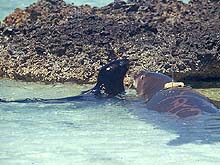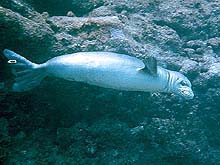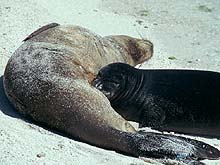Monk Seals: 'Dogs that Run in the Sea'
Christopher Kelley, Program Biologist
Hawai‘i Undersea Research Laboratory
![]() Watch underwater video shot with a camera attached to a monk seal swimming in shallow coral-reef habitat. (mp4, 8.9 MB)
Watch underwater video shot with a camera attached to a monk seal swimming in shallow coral-reef habitat. (mp4, 8.9 MB)
Monk seals are the most primitive living pinnipeds (seals, walruses, and sea lions) in the world. Three species are known to science: The Mediterranean monk seal, Monachus monachus, the Caribbean monk seal, Monachus tropicalis, and the Hawaiian monk seal, Monachus schauinslandi. The numbers of the Caribbean monk seal were historically reduced by hunting, but more recently, factors such as disturbance, loss of habitat, reduction in prey resources, and fishing interactions contributed to the demise of the species. The last sighting of one of these animals occurred in 1952, and in 1996, the species was officially declared extinct.
The Mediterranean and Hawaiian monk seals are close to the brink as well, with their populations currently standing at 500 and 1,400 animals, respectively. The main cause of their decline is similar to that of the Carribbean subspecies. In addition, Hawaiian seals suffer disease and the risk of entanglement in marine debris. For seals in the Mediterranean, direct fishery interactions represent the most significant problem. Both species are now listed as critically endangered, and efforts are being made to protect the remaining populations.
Endangered Loners
The Hawaiian monk seal was designated as endangered under the Endangered Species Act of 1976. The population is currently estimated at 60% of the population documented in the late 1950s, and there is no evidence to indicate the population will begin growing in the near future.
A Hawaiian name for monk seal is “ilio-holo-kai,” which translates to “the dog that runs in the sea.” The western name for these animals may have been inspired by their solitary, monk-like existence. While aggregations do occur, these animals are commonly alone when encountered. This makes it more difficult for researchers to learn what they need to know about the seals' biology in order to enhance their recovery.
Further complicating things is the fact that Hawaiian monk seals live almost exclusively in the Northwestern Hawaiian Islands. The largest numbers are found hundreds of miles from civilization, around the French Frigate Shoals. Collecting data on these species requires dedicated researchers spending long hours at sea on ships, or camping out for months at a time on these remote spits of land.
These animals are easier to study when they have “hauled out” onto the beach, which they do when molting, birthing, or resting. Adults typically average over 400 lbs and are more graceful in the water than on land. Pregnant females may weigh up to 600 lbs before giving birth. Researchers are required to obtain special permits to study these animals because any handling or disturbance on land or in the water is against the law.

Hawaiian monk seal fitted with a satellite tracking tag and pup. (Source: Chad Yoshinaga.) Click image for larger view.
Sea 'Runners'
Monk seals are much more difficult to study when they're out at sea feeding. What they eat has been determined primarily by analyzing their feces. Fish and invertebrates, including eels, octopuses, and crustaceans, are all part of their diet. Other crucial information, such as where they feed, is very hard to obtain. These fast, efficient swimmers are virtually impossible to follow underwater.
As a result, researchers have turned to high technology to get the answers they need. Monk seals have been fitted with small satellite transmitters to track their movements and with special cameras to videotape what they see when they are diving. As a result, it is now known that some travel considerable distances, and dive to depths of 800 ft or more to feed.
Sign up for the Ocean Explorer E-mail Update List.






















